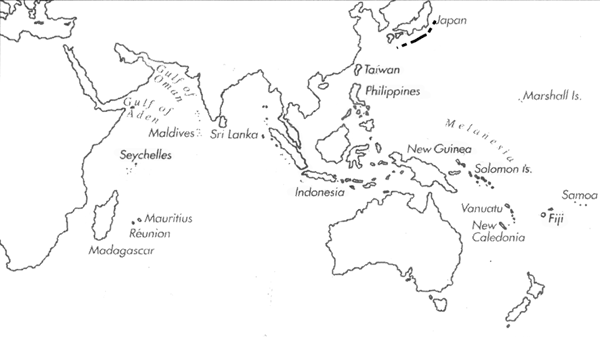Range: Japan.
Description: Moderately small to medium-sized, light to moderately light. Last whorl conical to ventricosely conical; outline slightly convex, left side sometimes sigmoid. Shoulder angulate to subangulate, occasionally weakly undulate. Spire of moderate height, variably concave in outline. Postnuclear spire whorls weakly tuberculate to almost smooth. Teleoconch sutural ramps flat, with 2 increasing to 4-6 spiral grooves. Last whorl with a few weak, widely spaced spiral ribs above base.
| Shell Morphometry | ||
|---|---|---|
| L | 25-40 mm | |
| RW | 0.04-0.10 g/mm | |
| (L 24-38 mm) | ||
| RD | 0.57-0.61 | |
| PMD | 0.83-0.88 | |
| RSH | 0.13-0.16 | |
Ground colour mixed bluish grey and tan. Last whorl encircled with brownish violet, leaving a ground-colour band at centre and at base. About 10-20 rather evenly spaced dotted brown spiral lines extending from base to shoulder. Apex pink. Late sutural ramps crossed by brown streaks or blotches. Aperture pale violet, darker above centre.
Habitat and Habits: Shallow water.
Discussion: C. pauperculus seems related to C. boeticus, from which it differs in its lighter weight, its smoother outer edges of the late sutural ramps, and the weak spiral sculpture as well as the dull brownish violet colouration of the last whorl. Specimens from Philippines (see Appendix 2, no. 30, P1. 73, Figs. 10- 12) with a brown colour pattern with coarse, brown spiral lines, may belong to C. pauperculus, but differ in conical last whorl, white ground colour, light brown apex, and higher relative weight (RW more than 0.13 g/mm).

C. pauperculus Range Map
This section contains verbatim reproductions of the accounts of 316 species of Conus from the Indo-Pacific region, from Manual of the Living Conidae, by Röckel, Korn and Kohn (1995). They are reproduced with the kind permission of the present publisher, Conchbooks.
All plates and figures referred to in the text are also in Röckel, Korn & Kohn, 1995. Manual of the Living Conidae Vol. 1: Indo-Pacific Region.
The range maps have been modified so that each species account has it own map, rather than one map that showed the ranges of several species in the original work. This was necessary because each species account is on a separate page on the website and not confined to the order of accounts in the book.